The Proas of John Pizzey - Part 2
My introduction to modern proas, after designing, building and sailing my offshore catamarans, was aboard Tony Williams’ proa. It worked extremely well, was fast, fun and controllable but a bit complex in its rig. However it scored with no rudders or centreboard and was steered very effectively by the sail which was set on a spar with a central boom at the end of a gantry like mast. I grew fond of that sail arrangement and endeavoured to incorporate it on one of my proas. It could tip over to windward, believe me. I still like that arrangement and if it could be tamed for use in all conditions it is worthwhile considering. I have looked at a combination of two smaller such sails but I see interference problems especially if caught aback.
My Addwater proa, Flight, is a narrow flying proa which is self righting from a knockdown, proven on countless occasions. It utilized a rig canted off to leeward. The cant angle was fixed bit it could be made adjustable for wind strength, laid off for heavy winds and only slightly off upright for light winds, this allows the sail weight to curve the sail to the airfoil shape and enables the boat to sail in a breeze so light every other boat has stopped. In such conditions, Flight would keep sailing and be readily controlled, shunted and sailed in any sailing direction giving great pleasure. In this situation the big isosceles triangle sail is tops - like a big reacher.
A cruising boat must also be practical and for me this rules out having a pod sticking out from the side of the main hull, must be awkward in marinas or when rafting up with other boats to fully enjoy the pleasures of cruising or welcoming their boarding party with the nose of their allycan or its outboard motor belting up against the underside of the pod, can’t those b*stards be more considerate, even if they are half tanked and they forgot to set their dinghy painter considering wind against tide and washes from passing speedboats, for heaven’s sake!
I have tried many rudder combinations: inboard; in main hull and in the float; formed as articulated ends of the hull; as well as hung from the side of the main hull and from the float.
The final form used in Pi was a spade rudder at each end of the float, one a balanced spade steered manually by a wheel which rotated about a transverse axis and the other a symmetrical spade adjusted, and held against rotation by a hydraulic ram and operated from a button next to the helm. This was fantastic. The electrically operated spade could be adjusted to provide lift whether at the front or the back and the boat steered with the other rudder, wether at the front or the back. This improved windward performance remarkably as both rudders were at all times providing lift to windward. I would always incorporate an arrangement in which I could take this advantage which is peculiar to proas.
The rudder shafts of Pi were inclined slightly fore and aft and I made foils to sit underneath the rudders at the same angle such that the rear foil would always be horizontal and the front foil inclined with a positive angle of attack equal to double the inclination of the rudder posts, so as to positively lift the float bow. I never fitted these foils as the lift in Pi came mostly from the sails. She was already extremely radical but surprisingly successful after sorting out a few teething issues.
Unfortunately because of the toll the sun had taken on both Helen and myself from years of sailing, Pi was converted to a power boat with a large covered cockpit and very successfully: 42ft long, a 100HP outboard alongside the main hull and a 50HP on the float. Pi does 20+knots flat out and cruise at 10k using about 10 liters per hour.
On Flight I eventually abandoned the articulated ends and went to spade rudders in cases so they could be raised for beaching. Flight, with no rocker, floats in less than 6 inches of water from memory. I prefer to leave both rudders down with the front locked at a positive upwind bias.
On the subject of rudders, I would not use out-hung rudders as they are likely to be damaged by visiting dinghies or stray sheets that are tightened bar-tight before the culprit realizes that he has broken the rudder. If it can happen it will, so for my money, the rudder should be in the hulls or if out-hung, made damage proof.
As a youth I was fortunate to sail on a 15m sailing dugout in the Torres Straight, not a proa but a trimaran configuration with live crew ballast and a skipper who held a large curved plank in lee board fashion in a gap between the side of the main hull and a plank lashed alongside and which he manipulated, mostly up and down, to control the craft’s direction, what a blast.
In my experience there is nothing like sailing a narrow hulled multihull on one hull in moderate and light conditions without any effort or skill on your part or fear of capsize. One narrow hull slicing through the water, not reacting severely to waves as would a broad beamed hull such as a monohull and at speed and not being bucked by wave reaction on the other hull, simply gliding gracefully and comfortably across the water.
When returning from a Gladstone race start one year on Piawatha, in very windy weather, we were passed by a large passenger ferry also returning from the start spectacle. They passed just as we were flattened by a gust and we could hear the gasps from the sightseers on board followed by cheers when she sedately self-righted. She was rigged with the isosceles triangle sail at the time. probably with outboard rudders hanging from the inside of the main hull.
Looking at the photos of Piawatha reminds me that I started with centreboard cases in the ends of the downwind float and the rudders were at the bottom of respective daggerboards. I also had a big and cumbersome bale rig which pivoted about a fixed balance point for low sheet forces. I recall the combination was too awkward and I suspect that instead of fixing one problem at a time I installed a central centreboard and a new rig at the same time. Thus the bale rig never had a fair go, and perhaps it was too big as a fully battened sail 300ft² in area.
Wether by choice, fortuitous accident or convenience, (I probably did think about it because I also reduced the overall beam by about 2ft and installed the outhung rudders) I installed the new centreboard case alongside the inboard hull so the board was canted to windward. This provided vertical lift as well as lift to windward, which increased as the craft heeled until the float cleared the water then the area of the board in the water reduced as did the vertical lift. At the same time the inclined rig was rapidly losing its overturning moment and presto, automatic hull flying with no effort on the skipper’s part. In fact you could go below and make a cuppa while you sailed along on one hull. Now that’s what I call sailing - demo for the camera!
John Pizzey 2013
P.S.: My NEXT proa, will definitely be a flying proa with central canted centreboard in float, retractable rudders in cases in the main hull, fore and aft pivoting mast(s) laid off to leeward, definitely self righting from a knockdown which tends to rule out the Tony Williams type sail as when that hits the water there is too much that could go wrong, so probably back to the sail makers to see what they can do to make a soft isosceles triangle sail perform in stronger winds, perhaps leech lines like a hang-glider, that is basically like Flight. I have worked out a rudder control system to make it as convenient as a conventional boat tiller without concern for reversing of the rudder. That’s one more hurdle out of the way, at least in my dreams.
My plan is to cut Flight up and reassemble its bits to make another proa more suited to my age with a bit of comfort, shade and all that stuff. The conventional mast and jib has great appeal as an “off the shelf” solution. My basic objection is that while the fixed main is great in that wind pressure on it when reversing to shunt induces the craft to pivot to its new heading, as did the sails on Pi, in its new aft position it will quickly point you up into the breeze and you may be caught in irons and struggle to get underway again, whereas with a sail out front you will always head off on the new tack upon trimming the sail. The fixed boom may also be a problem in a knock down and when caught aback, unlike the soft sail which can flail harmlessly if all sheets are let go. Perhaps the pivoting mast could have a pair of furled ¾ jibs limiting its forward movement, the front one being utilized to pull and fix the mast in the new position (in fact pivoting is achieved mostly by wind pressure) and be ready to be unfurled for action. The other advantage of the large isosceles triangle sail is that with barber haulers it can readily act like a spinnaker.
Unlike conventional sailboats there are just too many options and that’s what I like about proas, you’ve got to back yourself and put your money where your mouth is. A massive failure would be devastating while success against the odds is good for the being.
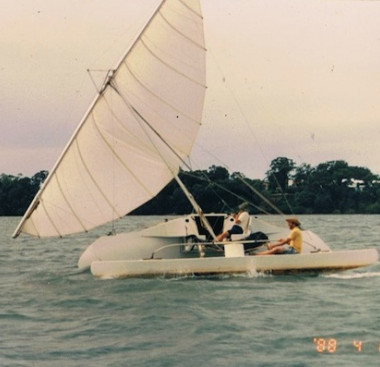
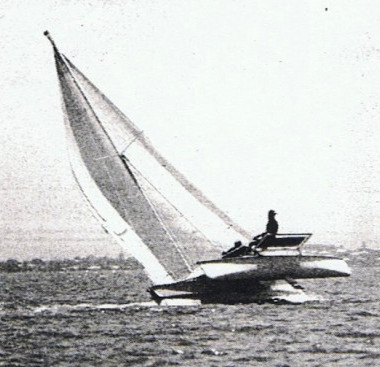
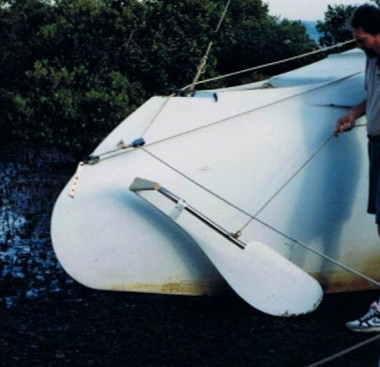
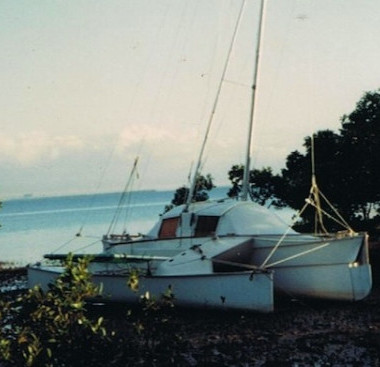
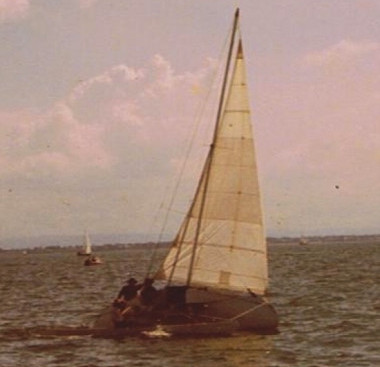
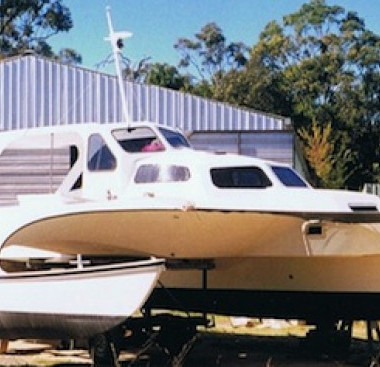
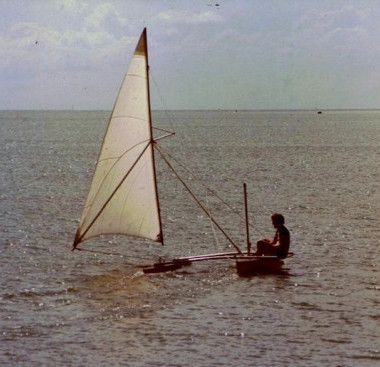
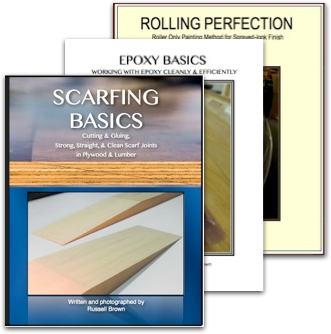
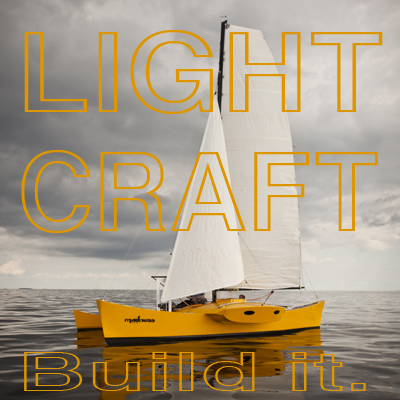
That last photo on the list there is a fascinating one. You don’t see very many pacific proas set up with the larger hull to windward. Is there a name for this particular type of design/arrangement? Of course it bears some similarity to the Harryproa design of Rob Denney, but not overmuch.